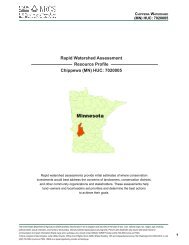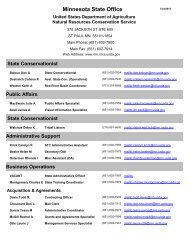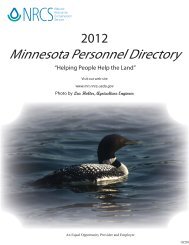Living Landscapes in Minnesota: - Minnesota NRCS - US ...
Living Landscapes in Minnesota: - Minnesota NRCS - US ...
Living Landscapes in Minnesota: - Minnesota NRCS - US ...
Create successful ePaper yourself
Turn your PDF publications into a flip-book with our unique Google optimized e-Paper software.
In the development and ma<strong>in</strong>tenance of a native landscape, water conservation is the driv<strong>in</strong>g<br />
force beh<strong>in</strong>d effi cient and aesthetic designs. Plants should be grouped <strong>in</strong> separate water-use zones<br />
accord<strong>in</strong>g to their water needs and function with<strong>in</strong> a landscape. Monitor<strong>in</strong>g soil moisture to<br />
determ<strong>in</strong>e when to irrigate is better than us<strong>in</strong>g a pre-set schedule. Th e soil water-hold<strong>in</strong>g capacity<br />
will vary with soil type, amount of organic matter, and climatic conditions.<br />
Supplemental Water Requirements<br />
Seed<strong>in</strong>gs: A moist soil profile, at time of plant<strong>in</strong>g, will <strong>in</strong>crease seed<strong>in</strong>g<br />
success. Water<strong>in</strong>g should be done <strong>in</strong> frequent, light applications dur<strong>in</strong>g<br />
the first 4 to 6 weeks to ensure good seed germ<strong>in</strong>ation, emergence, and<br />
root development. The use of an organic mulch can reduce the potential<br />
fluctuations <strong>in</strong> surface soil moisture and soil temperature dur<strong>in</strong>g this critical<br />
establishment period. New seed<strong>in</strong>gs without mulch may require light water<strong>in</strong>g<br />
2 to 3 times per day to ma<strong>in</strong>ta<strong>in</strong> soil surface and seed moisture.<br />
Transplants: Young transplants require frequent and regular water<strong>in</strong>g until<br />
root development can provide the proper shoot to root ratio. Some woody<br />
species (oak <strong>in</strong> particular) spend several years develop<strong>in</strong>g an extensive root<br />
system before a correspond<strong>in</strong>g <strong>in</strong>crease <strong>in</strong> above-ground development is<br />
realized.<br />
Established Plant<strong>in</strong>gs: There are two times dur<strong>in</strong>g the year when it is critical<br />
that the root<strong>in</strong>g zone of a plant be at or near field capacity – fall and early<br />
spr<strong>in</strong>g. Fall moisture is essential for the health and vigor of plants for w<strong>in</strong>ter<br />
survival. Evergreens, <strong>in</strong> particular, should be deep watered <strong>in</strong> late fall to<br />
prepare for possible warm periods dur<strong>in</strong>g the w<strong>in</strong>ter months. As temperatures<br />
rise <strong>in</strong> the spr<strong>in</strong>g, water is needed to support rapid early growth.<br />
<strong>Liv<strong>in</strong>g</strong> <strong>Landscapes</strong> <strong>in</strong> M<strong>in</strong>nesota: A GUIDE TO NATIVE PLANTSCAPING<br />
WATER CONSERVATION<br />
23<br />
Water is wasted when applied too heavily<br />
or rapidly. Excessive slope and poor<br />
location for turf area contribute to runoff.<br />
Low pressure spr<strong>in</strong>kler systems<br />
conserve water by deliver<strong>in</strong>g small<br />
amounts exactly where needed.<br />
Other Considerations<br />
• South and west exposures<br />
require more frequent water<strong>in</strong>g<br />
than north or east exposures.<br />
• Slop<strong>in</strong>g landscapes require<br />
water to be applied more slowly<br />
than flat surfaces to allow<br />
adequate <strong>in</strong>filtration and prevent<br />
runoff.<br />
• Berms or terraces hold water<br />
and stabilize severe slopes.<br />
• Avoid us<strong>in</strong>g spr<strong>in</strong>klers that throw<br />
a f<strong>in</strong>e mist high <strong>in</strong> the air. Water<br />
between 5-8 AM.<br />
• Avoid water<strong>in</strong>g dur<strong>in</strong>g hot, w<strong>in</strong>dy,<br />
or ra<strong>in</strong>y weather.<br />
• Design plant<strong>in</strong>gs and structures<br />
to capture snow for additional<br />
moisture.






